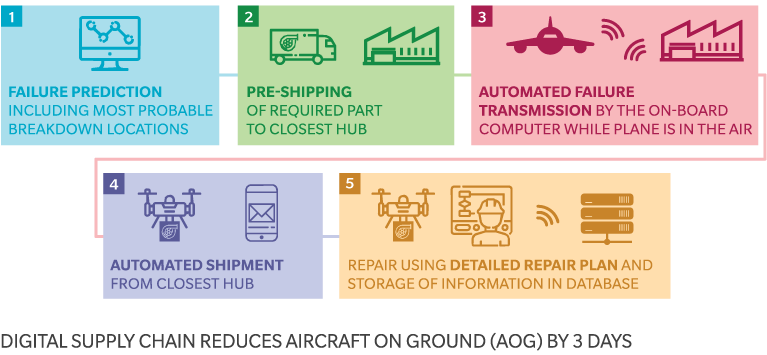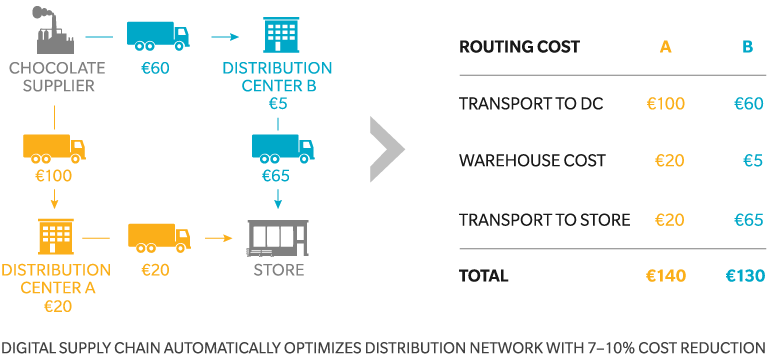The rise of e-commerce and digital distribution has forced many players to rethink their supply chain models. The traditional supply chain model was designed to efficiently push orders to customers. It delivered goods, but didn’t deliver a differentiating value to the customer. A digital supply chain, on the other hand, which uses data and advanced analytics in combination with technology, combines efficient delivery with additional value-add.
At its most basic level, the digital supply chain breaks silos and better connects sales to operations
At its most basic level, the digital supply chain breaks silos and better connects sales to operations. At a more advanced level, the digital supply chain leverages data to make better use of advanced analytics for faster and better decisions. Rather than relying only on company-specific data, the digital supply chain ideally uses data from all players—and even leverages external, non-sales data from sources such as Twitter, Facebook, or weather forecasts.
In aviation, for example, a digital supply chain can increase aircraft uptime through prediction of breakdowns, improved spare-part availability and lightning fast shipping (see “Scenario: Aviation Spare-Part Digital Supply Chain”). In retail, digital supply chains reduce the cost of logistics due to real-time, business case-based distribution network configurations (see “Retail: Dynamic Distribution Configuration”), which allows greater agility and responsiveness to variations in demand.
Transformation to a digital supply chain
Transformation from a traditional to a digital supply chain starts with a diagnostic of the current supply chain to determine what digital elements are already in place. The next step is to define a target picture of the supply chain so a well-tailored transformation roadmap can be drawn. The supply-chain organization needs to grow beyond its silo into a fully integrated, horizontal, and agile function interacting with all key other functions in the firm.
With a roadmap in place, you can focus on injecting digital elements one by one. These include, for example, predictive forecasting with algorithms, definition of rule sets for decision-making in automated processes, machine-learning algorithms to understand issues such as quality or transportation bottlenecks or even by automating operations with robots.
For real-time adjustments, the supply-chain organization needs to build up its own data-analytics capabilities—and not depend on the data-science department. IT systems need to be connected and integrated along the supply chain, as well as to operations such as logistics, so that trucks can be automatically dispatched or re-routed.
Developing a fully digitized supply chain requires a massive transformation. By starting with a pilot, learning what works, and then commencing full-scale implementation of high-yield elements, significant impact can be quickly realized and organizational overload avoided.
In the age of e-commerce and Amazon, the potential impact of a digital supply chain manifests itself in improved EBITDA, faster delivery, a better customer experience—as well as the opportunity to add value-added services to existing products.
Aviation Scenario: Predictive Forecasting for Replacement Parts
Imagine that an airline forecasting system predicts with a probability of 60 percent that a thrust reverser on a plane will fail within 18 to 22 days—likely in either Chicago or Atlanta. The airline orders the required thrust reverser from a distributor, and ships it to the central warehouse of the logistics company.
When the predicted breakdown occurs in Chicago, the on-board computer transmits the requirement for a new part to the Airline. Within 15 minutes, the part is labelled and sent via express air-cargo for same-day delivery.
The technician in Chicago receives the part along with a detailed repair plan on his tablet. Since the damaged thrust reverser cannot be repaired, it is sent back to the manufacturer to determine the cause of the breakdown. All relevant data is saved in a central database to further increase future prediction quality.
What’s the impact? Automatic detection of the part failure by sensor saves time searching and ordering a replacement part. Advance prediction of the breakdown location enables early shipping and decreases delivery time. Overall AOG is decreased by 2.5 days, and logistics costs by 60 percent.
Exhibit 1: Airline Part Replacement

Retail Scenario: Dynamic Distribution Configuration
Digital supply chains enable retailers to reduce logistics cost due to real-time, business case-based distribution configuration. For example, using a traditional supply-chain model, a supermarket always orders chocolate from the nearest distributor. But when numerous stores order at the same time, the nearest distributor suffers capacity overloads, which leads to additional warehouse costs and delayed deliveries. Total delivery cost: €140 per store.
With a digital supply chain, the distribution planning system has full transparency over available space in all distribution centers, all store orders, and delivery times and costs from the two distribution centers to the store. The business cases show that delivery from the second closest distributor is more cost-efficient, as there is a short-term available cross-docking slot that can be used, thus considerably reducing warehouse cost. Total delivery cost: €130.
For a medium-sized retailer with a few thousand stores, saving 10€ per delivery translates to an annual savings in the double-digit, million-euro range.
Exhibit 2: Dynamic Distribution Configuration











